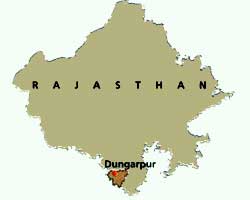<font class=UCASE><b>dungarpur</b></font> <br> A common death
 when Bhuna Bhil of Pathara village in Dungarpur ran away from the communal carnage in Gujarat, he faced a dilemma: what would he do back in his village? It had already exhausted all his sources of livelihood.
when Bhuna Bhil of Pathara village in Dungarpur ran away from the communal carnage in Gujarat, he faced a dilemma: what would he do back in his village? It had already exhausted all his sources of livelihood.
Known as the 20th century desert, Dungarpur's 68 per cent population has been classified as marginal and unemployed by the District Statistical Profile 2000 of the state government. Every traditional source of livelihood in the village has either degraded or is kept out of people's reach. For example, forests that used to form 60 per cent of the district in 1943 has been reduced to just 12.5 per cent in 1999, according to the State of Forest Report. Local people say this is due to a nexus between timber traders and forest officials. In the early 1990s, a massive tribal uprising against large-scale deforestation forced the government to check commercial felling. With forests unable to sustain livelihoods, villagers began depending more on agriculture and livestock to supplement their income using the common property grazing lands.
The story of Bhuna illustrates the district's swirl of poverty caused by the wind of ecological change. Villagers have been migrating to Gujarat for the last five years as their own land is unsuitable for a second crop. Their second line of defence, livestock, has also fallen prey to the government. There is just not enough grazing land to feed the animals.
Till a few years ago, vast grasslands in the village supported the livestock of this village. The village had clearly defined rules about the use of this common resources. With a rainfed nala flowing nearby, the village was
